Whether you’re curious about how Christmas traditions began, seeking inspiration for your own celebrations, or simply fascinated by how different cultures mark this special time of year, this guide offers a journey through time and across continents to uncover the many facets of this enduring holiday that brings light to the darkest days of winter and warmth to hearts around the world.
Historical Origins of Christmas
The history of Christmas weaves together religious significance, pagan traditions, and cultural evolution spanning thousands of years. Understanding these origins helps us appreciate how this holiday has become the multifaceted celebration we know today.
Pre-Christian Winter Celebrations
Long before the birth of Jesus, cultures around the world marked the winter solstice—the shortest day of the year—with festivals celebrating the return of light and the renewal of life. These ancient celebrations laid the groundwork for many Christmas traditions we still observe.
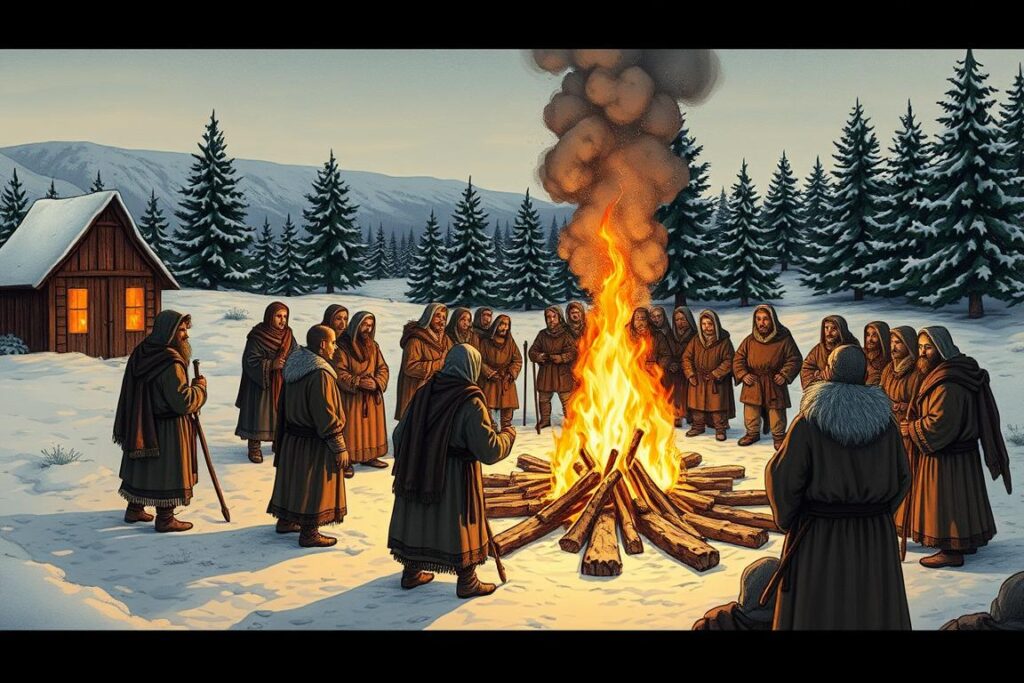
Roman Saturnalia
In ancient Rome, Saturnalia was celebrated from December 17-23. This festival honored Saturn, the god of agriculture, and featured feasting, gift-giving, and a temporary reversal of social roles where enslaved people were served by their masters. The revelry, goodwill, and exchange of gifts during Saturnalia bear striking similarities to modern Christmas customs.
Germanic Yule
Northern European cultures celebrated Yule from late December through early January. The Norse and Germanic peoples marked this midwinter festival by bringing home large logs (Yule logs) to burn while feasting until the log was consumed. Each spark from the fire was believed to represent a new animal to be born in the coming year. The tradition of decorating with evergreens also stems from these celebrations, as they symbolized life persisting through the dead of winter.
Sol Invictus
The Roman festival of “Dies Natalis Solis Invicti” (Birth of the Unconquered Sun) was celebrated on December 25th. This holiday honored the renewal of the sun and the lengthening of days following the winter solstice. The timing of this celebration would later influence the date chosen for Christmas.
Establishment of December 25th as Christmas
The Bible does not specify the date of Jesus’s birth, and early Christians did not celebrate it. The earliest Christmas celebrations began in Rome around 336 CE, but why was December 25th chosen?
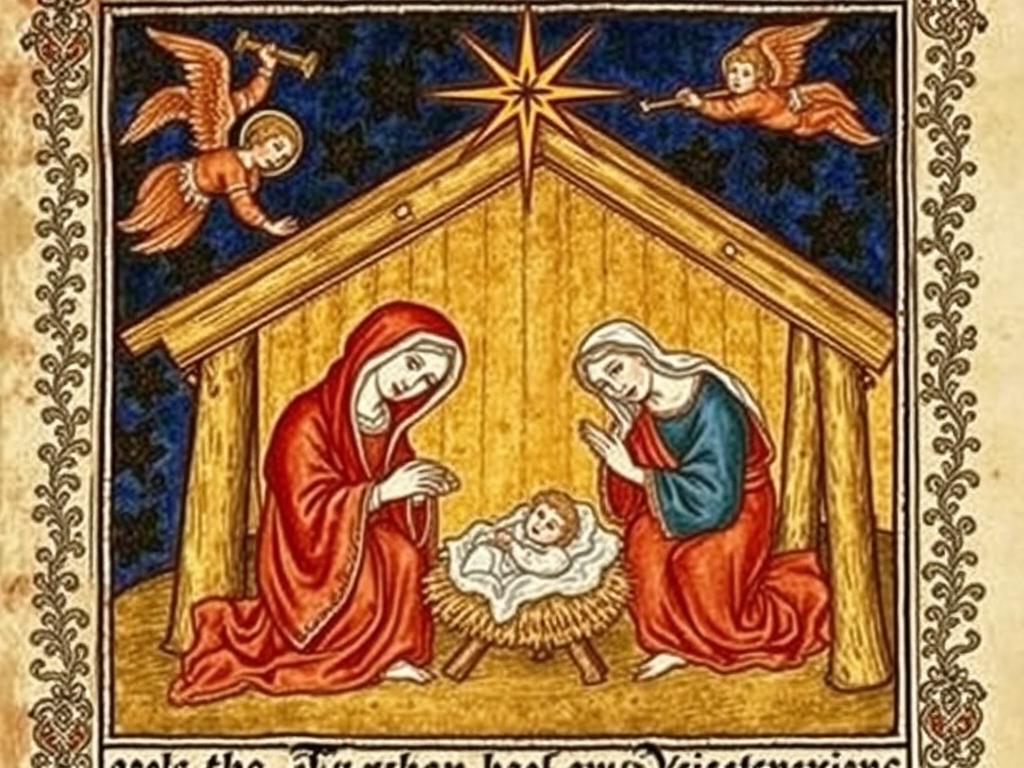
Two main theories explain the selection of this date:
The Calculation Theory
Some early Christians calculated Jesus’s birth date based on the belief that great prophets were conceived on the same date they died. Since they believed Jesus died on March 25th (the spring equinox in the Roman calendar), they placed his birth nine months later—December 25th.
The History of Religions Theory
This theory suggests that the church chose December 25th to coincide with existing pagan festivals like Saturnalia and Sol Invictus. By establishing Christmas during these celebrations, the church could offer a Christian alternative and ease the conversion of pagans to Christianity.
Early Christmas Celebrations
Early Christmas celebrations were quite different from today’s family-centered holiday. In medieval Europe, Christmas was a rowdy, carnival-like affair more akin to modern Mardi Gras than our current traditions. The poor would visit the homes of the wealthy demanding food and drink, with the implicit threat of mischief if they were turned away.
The holiday gained importance in the Christian calendar gradually. By the Middle Ages, it had become one of the most important Christian feasts, though Easter remained the more significant religious observance. Christmas traditions varied widely across Europe, with each region developing its own customs.
Discover the Forgotten Christmas Traditions
Want to learn about ancient Christmas customs that have faded from modern celebrations? Download our free illustrated guide to forgotten Christmas traditions from around the world.
When Christmas Was Banned
Surprisingly, Christmas hasn’t always been embraced throughout history. During certain periods, the holiday was actually outlawed, reflecting changing religious and political attitudes.
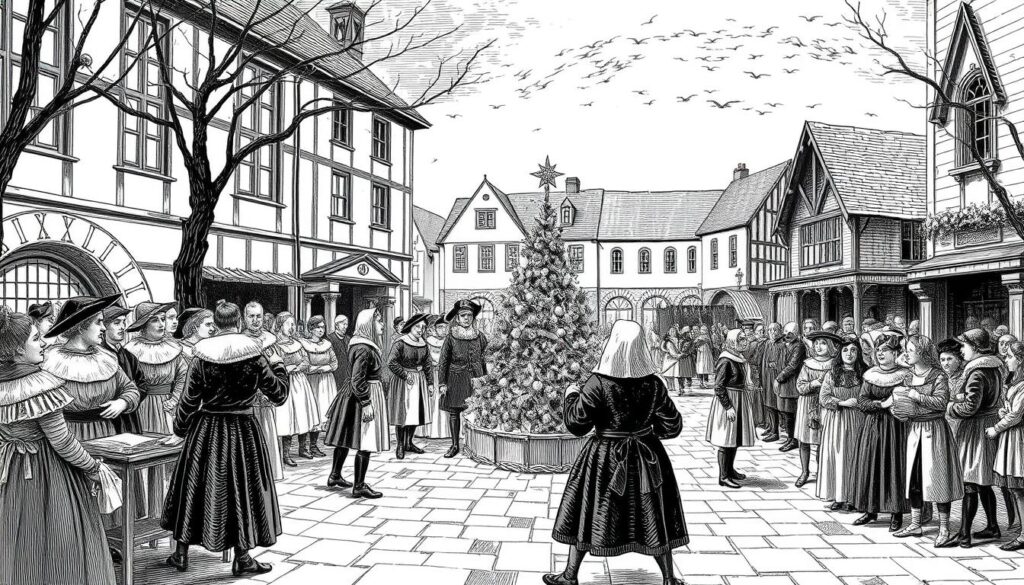
Puritan Opposition in England
In 1647, following the English Civil War, Oliver Cromwell and his Puritan forces took control of England and sought to rid the country of decadence. The Puritans, viewing Christmas as a pagan celebration with no biblical basis, banned it entirely. Christmas decorations were forbidden, shops were ordered to stay open, and ministers were arrested for preaching on Christmas Day. The ban remained until the restoration of the monarchy under Charles II in 1660.
Christmas Outlawed in America
In colonial America, the Puritans of New England shared this opposition to Christmas. From 1659 to 1681, anyone in Boston caught celebrating Christmas was fined five shillings. The day was so controversial that Congress even met on December 25, 1789, during the first Christmas under the new constitution.
This anti-Christmas sentiment persisted in some parts of America well into the 19th century. Schools and businesses commonly remained open on December 25th, and the day wasn’t declared a federal holiday in the United States until 1870.
“For preventing disorders arising in several places within this jurisdiction, by reason of some still observing such festivals as were superstitiously kept in other countries, to the great dishonor of God and offense of others, it is therefore ordered… that whosoever shall be found observing any such day as Christmas or the like, either by forbearing of labor, feasting, or any other way… shall pay for every such offense five shillings.”
Revival and Transformation of Christmas
The Christmas we recognize today largely took shape during the 19th century, when several cultural forces converged to transform the holiday from a rowdy public festival to a family-centered celebration of generosity and goodwill.
Victorian Christmas Revival
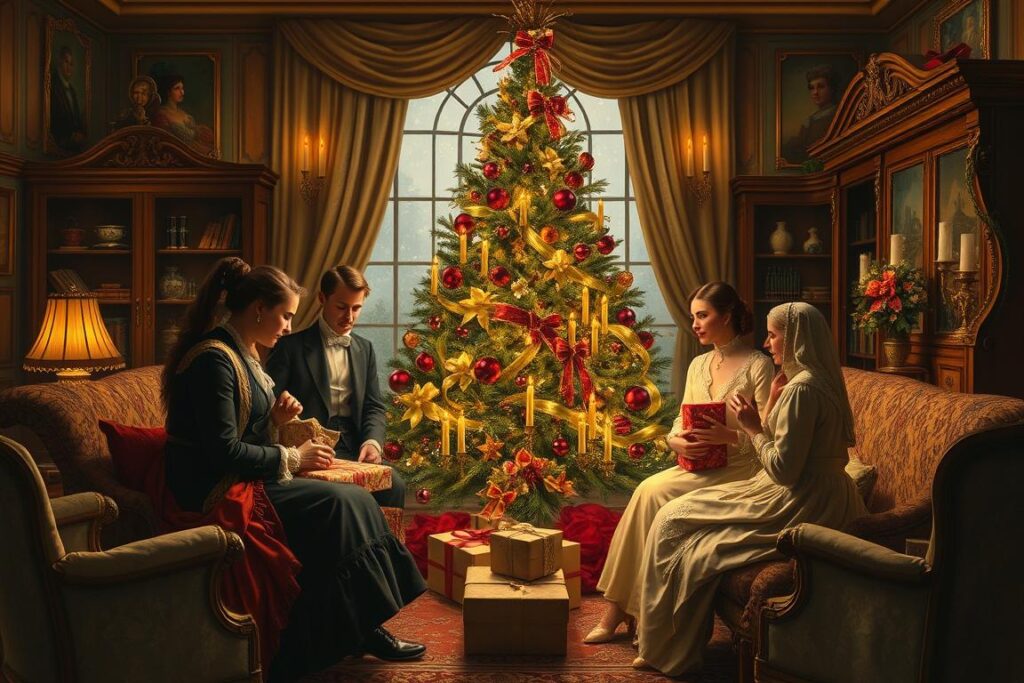
Queen Victoria and Prince Albert played a significant role in popularizing Christmas traditions. When the royal family was depicted in the Illustrated London News in 1848 gathered around a decorated Christmas tree—a custom Prince Albert brought from his native Germany—the tradition quickly spread throughout England and America.
The Victorian era saw Christmas transformed into a domestic celebration focused on children and family. New customs emerged, including elaborate Christmas dinners, the sending of Christmas cards (first commercially produced in 1843), and an increased emphasis on gift-giving.
Literary Influences
Literature played a crucial role in shaping modern Christmas. Washington Irving’s 1819-20 “The Sketch Book” depicted Christmas as a peaceful, warm-hearted holiday bringing together people across social boundaries. Though largely fictional, Irving’s account was presented as traditional English Christmas customs and helped create a new vision of the holiday.
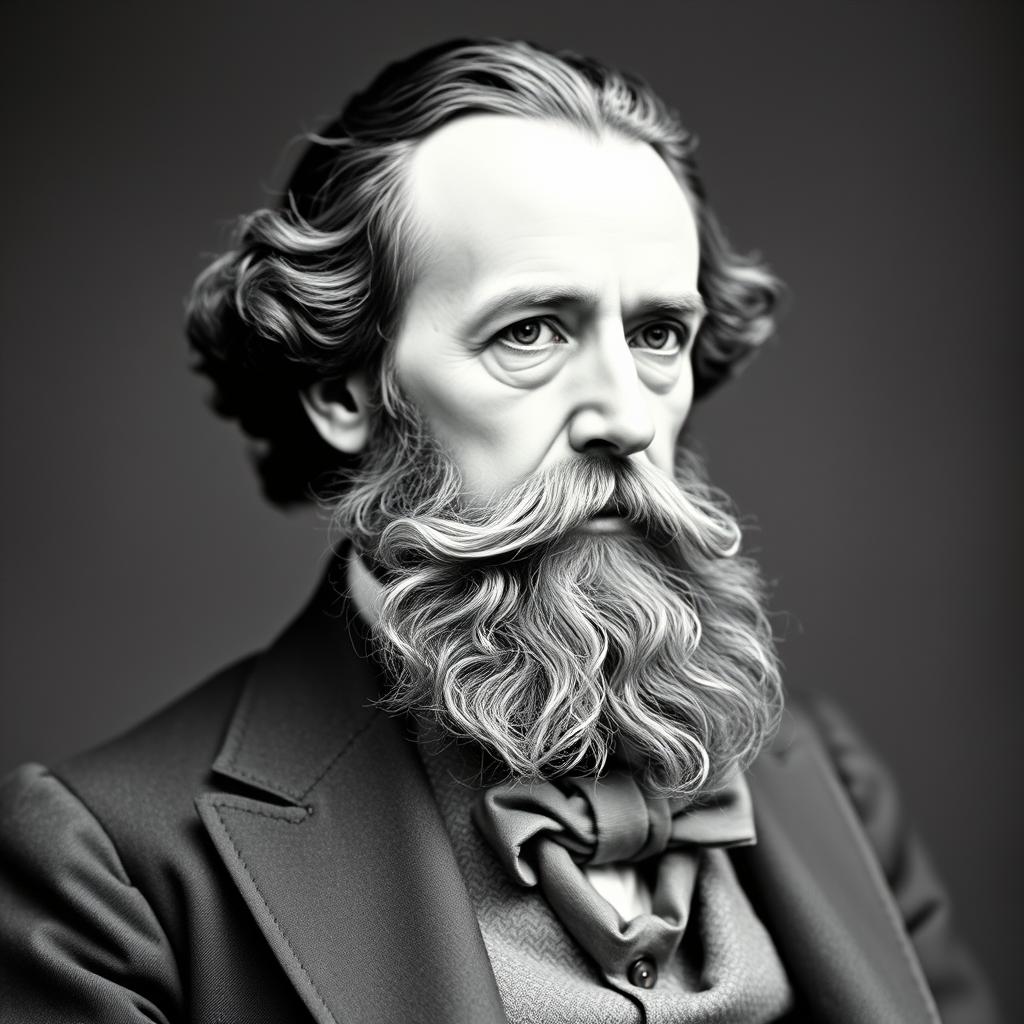
A Christmas Carol
Charles Dickens’s “A Christmas Carol,” published in 1843, had perhaps the most profound influence on modern Christmas. This tale of Ebenezer Scrooge’s transformation emphasized charity, family, and goodwill as the true spirit of Christmas. The immense popularity of this story helped cement these values as central to the holiday and contributed to its revival in Victorian England.
Dickens’s vision of Christmas—with its focus on family gatherings, seasonal food and drink, dancing, games, and a spirit of generosity—continues to influence how we celebrate today.
Commercialization of Christmas
The late 19th and early 20th centuries saw the gradual commercialization of Christmas. Department stores began creating elaborate Christmas displays and promoting the holiday as a time for shopping. The tradition of Santa Claus as a gift-bringer was emphasized in advertising, most notably by Coca-Cola, whose 1930s advertisements helped solidify the modern image of Santa as a jolly, red-suited figure.
By the mid-20th century, Christmas had become a major economic event, with retailers depending on the holiday season for a significant portion of their annual sales—a trend that continues to this day.
Religious Significance of Christmas
At its core, Christmas is a Christian celebration of the birth of Jesus Christ, whom Christians believe to be the Son of God and the savior of humanity. The religious aspects of Christmas remain central to many people’s observance of the holiday.
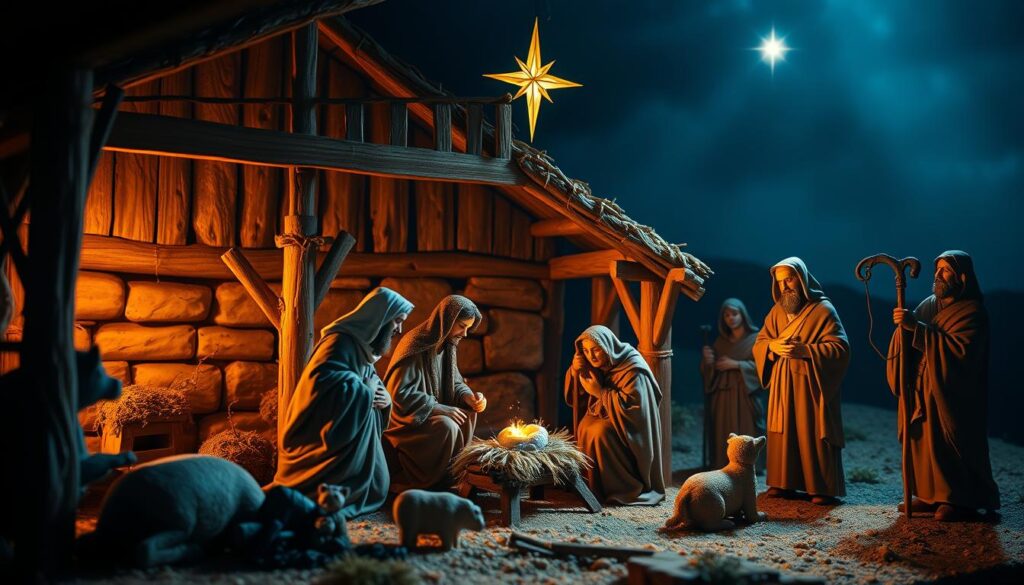
The Nativity Story
The biblical account of Jesus’s birth is found primarily in the Gospels of Matthew and Luke. According to these texts, Jesus was born to Mary, a virgin who had conceived through the Holy Spirit. The birth took place in Bethlehem, fulfilling Old Testament prophecies about the birthplace of the Messiah.
Key elements of the Nativity story include:
- The journey of Mary and Joseph to Bethlehem for a census
- Finding no room at the inn, leading to Jesus being born in a stable
- Angels appearing to shepherds in nearby fields, announcing the birth
- The visit of the Magi (Wise Men) from the East, following a star and bearing gifts of gold, frankincense, and myrrh
Religious Observances
Christians around the world observe Christmas with various religious traditions:
Advent
The four weeks preceding Christmas are known as Advent, a time of preparation and anticipation. Many Christians mark this period with Advent wreaths featuring four candles, lighting one each Sunday leading up to Christmas. Advent calendars, which provide a small gift or Scripture reading for each day from December 1-24, are another popular tradition.
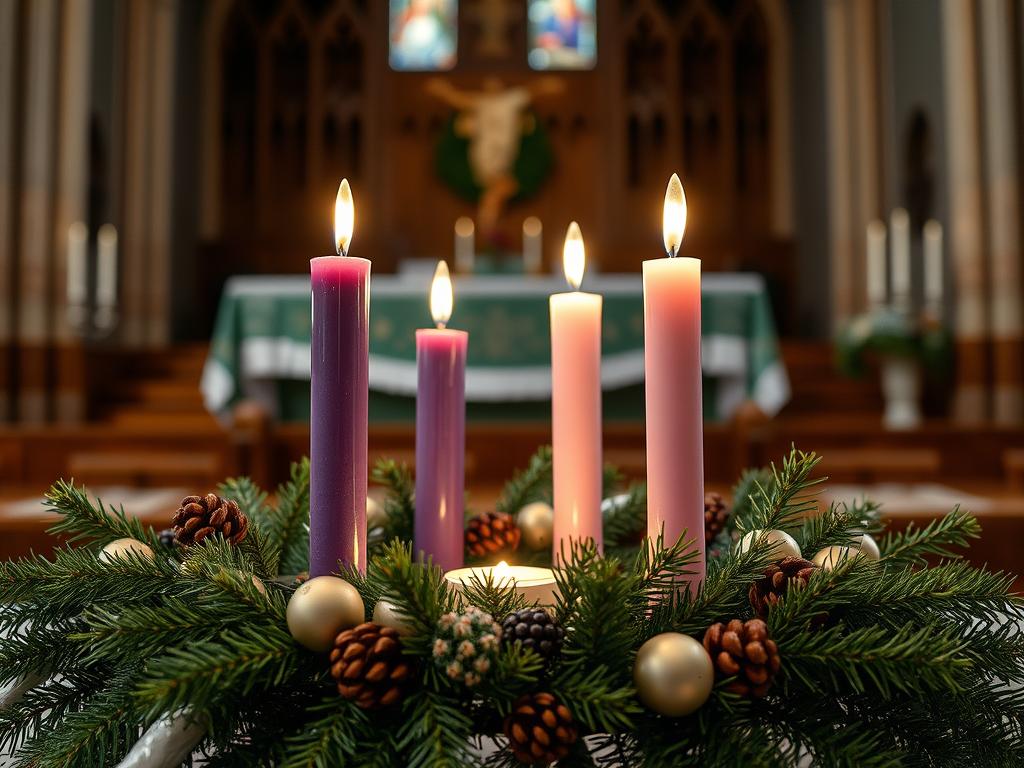
Christmas Eve Services
Many churches hold special services on Christmas Eve, including candlelight services, midnight Mass in Catholic traditions, and children’s pageants retelling the Nativity story. These services often feature special music, readings from the biblical accounts of Jesus’s birth, and the lighting of candles symbolizing Christ as the light of the world.
Christmas Day Worship
Christmas Day church services celebrate the birth of Jesus with special liturgies, music, and sermons. In many traditions, Christmas marks the beginning of the twelve days of Christmas, which extend from December 25 to January 6 (Epiphany), commemorating the visit of the Wise Men.
Is Christmas Really Jesus’s Birthday?
The Bible doesn’t specify the date of Jesus’s birth, and most biblical scholars believe it likely didn’t occur in December. The choice of December 25th was influenced by existing winter celebrations and theological calculations rather than historical evidence. The exact date of Jesus’s birth remains unknown, but the symbolic celebration of the event has become central to Christian tradition regardless of its historical timing.
The Evolution of Santa Claus
Few Christmas symbols are as universally recognized as Santa Claus. This beloved figure has evolved over centuries, blending historical figures, religious traditions, and literary creations into the jolly gift-bringer we know today.
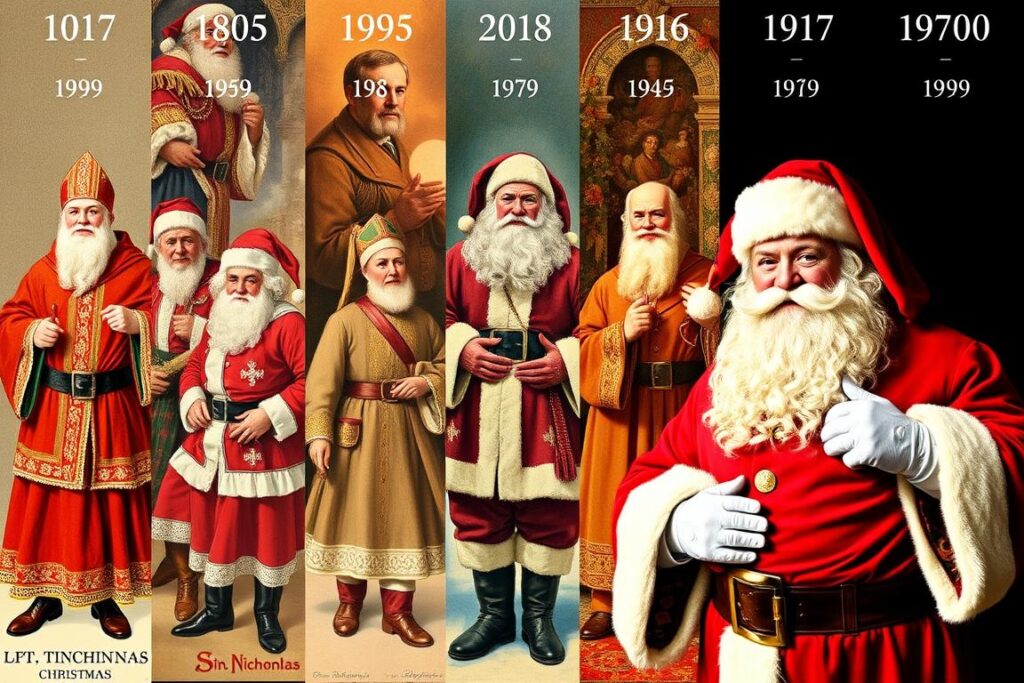
Saint Nicholas: The Historical Foundation
The Santa Claus tradition begins with Saint Nicholas, a 4th-century Christian bishop from Myra (in modern-day Turkey). Born to wealthy parents around 280 CE, Nicholas was known for his generosity and secret gift-giving.
The most famous story tells how he helped a poor man with three daughters who couldn’t afford their dowries. Nicholas secretly tossed bags of gold through their window at night (or down the chimney in some versions), saving the girls from being sold into servitude. This tale forms the basis of Santa’s secret gift-giving and connection to chimneys.
After his death on December 6, Nicholas was canonized as a saint. December 6th became St. Nicholas Day, when children in many European countries would receive small gifts in his honor.
European Variations
As Christianity spread throughout Europe, the veneration of St. Nicholas took different forms:
Sinterklaas
In the Netherlands, St. Nicholas became “Sinterklaas,” a bishop-like figure who arrived on a boat from Spain each December, riding a white horse and delivering gifts to good children. Dutch settlers brought this tradition to America, where “Sinterklaas” eventually transformed into “Santa Claus.”
Father Christmas
In England, the figure of “Father Christmas” emerged as a personification of holiday cheer and feasting. Unlike St. Nicholas, early Father Christmas wasn’t primarily associated with children or gift-giving, but rather with adult merrymaking and the spirit of good cheer.
Christkind
In parts of Germany and other European countries, the gift-bringer was the “Christkind” (Christ Child), a golden-haired child representing the baby Jesus. Ironically, this tradition was promoted by Martin Luther to shift focus from the Catholic saint Nicholas to Christ himself.
The American Santa Claus
The modern American Santa Claus emerged in the 19th century through several key developments:

Literary Development
In 1809, Washington Irving’s “Knickerbocker’s History of New York” depicted St. Nicholas as a pipe-smoking Dutch sailor in a green coat, flying in a wagon over treetops to deliver presents.
The 1823 poem “A Visit from St. Nicholas” (better known as “‘Twas the Night Before Christmas”), attributed to Clement Clarke Moore, established many elements of the modern Santa: his sleigh, reindeer team (including their names), his appearance as a jolly, plump man, his method of entering through the chimney, and his delivery of toys on Christmas Eve.
Visual Evolution
Political cartoonist Thomas Nast created a series of drawings for Harper’s Weekly from 1863 to 1886 that further developed Santa’s image. Nast gave Santa his workshop at the North Pole, his list of good and bad children, and his large, white beard and round belly.
By the early 20th century, Santa was typically portrayed wearing a red suit with white fur trim. The Coca-Cola Company’s advertising campaigns of the 1930s, featuring illustrations by Haddon Sundblom, helped standardize this image of Santa that remains dominant today.
Did You Know? Contrary to popular belief, Coca-Cola didn’t create the red-suited Santa. The red outfit was already common in illustrations before their famous ad campaigns, though they certainly helped popularize and standardize this particular image.
Christmas Trees and Decorations
Decorating for Christmas transforms ordinary spaces into magical winter wonderlands. These decorative traditions have evolved over centuries, blending practical, symbolic, and aesthetic elements.
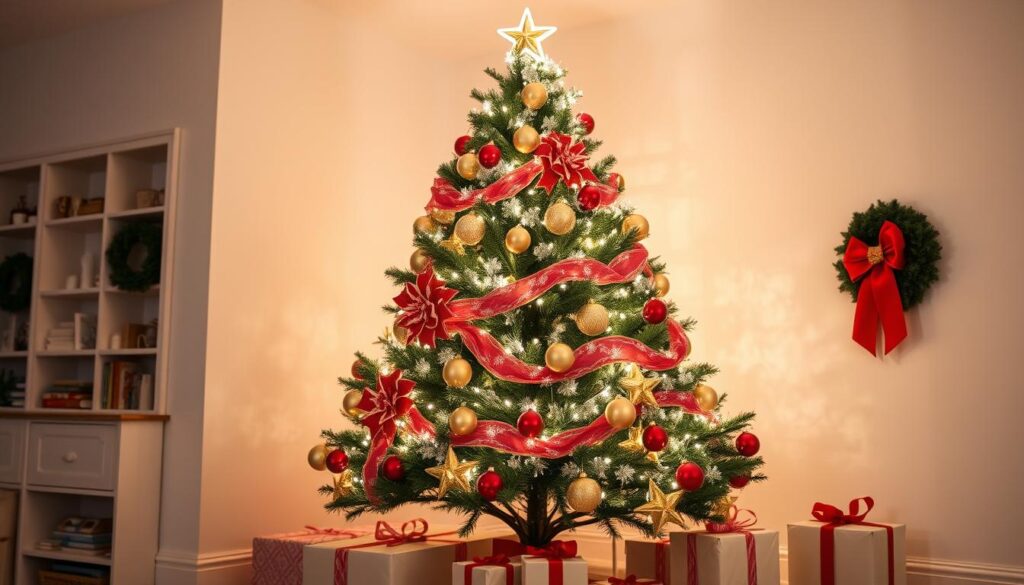
The Christmas Tree Tradition
The tradition of decorating evergreen trees has pre-Christian roots. Ancient peoples hung evergreen boughs over doors and windows during winter, believing these plants that remained green year-round held special power against evil spirits, illness, and death.
German Origins
The Christmas tree as we know it originated in Germany in the 16th century. Christian families brought decorated trees into their homes, and German settlers brought this custom to America in the 1800s. Several stories explain the origin:
- St. Boniface (8th century) is said to have encountered pagans worshipping an oak tree. He cut down the oak, and a fir tree grew in its place, which he declared a symbol of Christ.
- Martin Luther allegedly added lighted candles to a tree to recreate the starry night sky for his family after being inspired by a winter walk.
- Medieval “Paradise plays” used decorated fir trees to represent the Garden of Eden during performances on December 24.
Royal Influence and Global Spread
Christmas trees remained primarily a German custom until 1846, when a popular illustration showed Queen Victoria, Prince Albert, and their children gathered around a Christmas tree. Because Victoria was so popular, what was seen as a foreign custom quickly became fashionable in Britain and America.
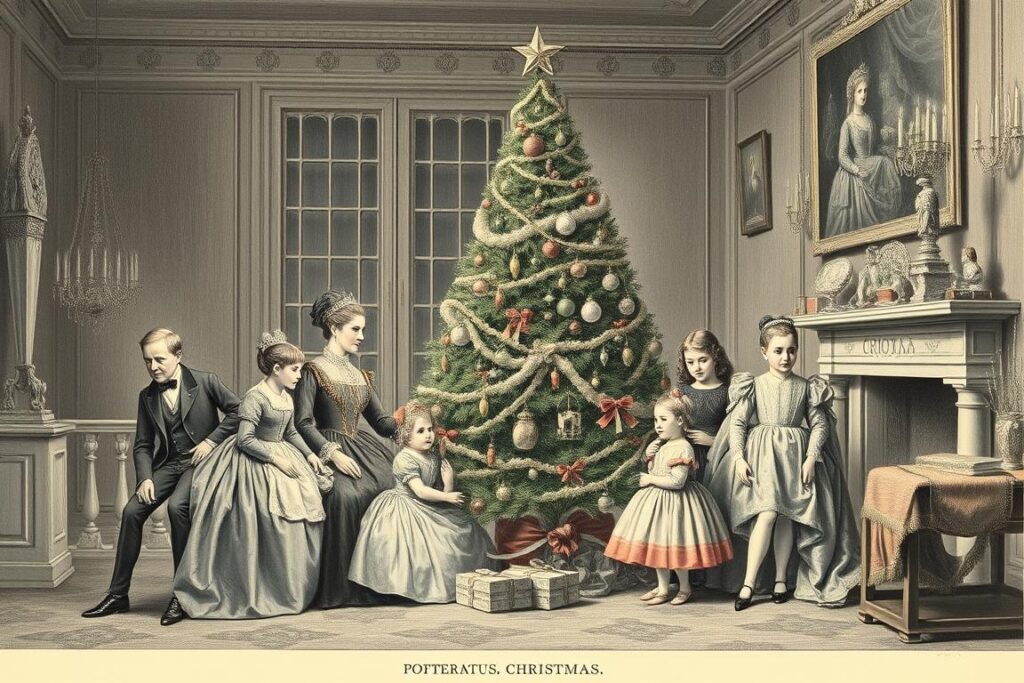
Traditional Christmas Decorations
Tree Ornaments
Early Christmas trees were decorated with candles, apples, nuts, and homemade ornaments. Glass ornaments began in Germany in the 16th century when a poor harvest led glassblowers to create fruit-shaped baubles. By the 1880s, F.W. Woolworth was selling $25 million in German glass ornaments annually in America.
Lights
Candles were the original Christmas tree lights, creating a beautiful but dangerous tradition. In 1882, Edward H. Johnson, a colleague of Thomas Edison, created the first string of electric Christmas lights for his tree. By the 1930s, electric lights were common on American Christmas trees and began appearing outdoors as well.
Greenery
Holly, ivy, and mistletoe have been used as winter decorations since pre-Christian times. Holly’s prickly leaves came to symbolize Christ’s crown of thorns and the berries his blood. Mistletoe was considered sacred by the Druids, and its association with kissing developed in England, where a berry was plucked with each kiss until none remained.
Symbolism in Christmas Decorations
Many Christmas decorations carry symbolic meaning:
- Evergreen Trees: Eternal life and persistence through hardship
- Star: The Star of Bethlehem that guided the Wise Men
- Angels: The heavenly hosts who announced Jesus’s birth
- Candles/Lights: Jesus as the “light of the world”
- Red: The blood of Christ
- Green: Eternal life
- Gold: Royalty and one of the gifts of the Magi
- Bells: Announcing the good news
Christmas Gift-Giving Traditions
The exchange of gifts is perhaps the most widespread Christmas custom today. This tradition has evolved from religious symbolism to a central feature of the holiday season worldwide.

Origins of Christmas Gift-Giving
Several influences contributed to the tradition of exchanging gifts at Christmas:
Biblical Inspiration
The most direct biblical connection comes from the gifts of gold, frankincense, and myrrh that the Wise Men brought to the infant Jesus. These gifts acknowledged Jesus’s importance and have inspired the Christian tradition of gift-giving to commemorate God’s gift of Jesus to humanity.
St. Nicholas Traditions
The legendary generosity of St. Nicholas, particularly his secret gift-giving to those in need, established a tradition of anonymous gifts during his feast day (December 6). As Christmas celebrations grew in prominence, these gift-giving customs gradually shifted to December 25.
Roman Influence
The Roman Saturnalia festival included the exchange of small gifts called “strenae,” often simple items like branches from sacred groves, later evolving to include more valuable gifts like honey, cakes, and coins.
Evolution of Christmas Gift-Giving
The practice of exchanging Christmas gifts has changed significantly over time:
Medieval and Renaissance Period
In medieval Europe, gift-giving was often associated with the Feast of St. Nicholas or with New Year’s Day rather than Christmas itself. Gifts were typically small tokens or handmade items, and the practice was not universal.
By the Renaissance, Christmas gift-giving had become more established among the upper classes, though still modest by modern standards. Gifts often included fruit, nuts, handmade items, and small luxuries.
Victorian Transformation
The Victorian era saw Christmas gift-giving become a central holiday tradition. As industrialization made consumer goods more affordable and available, store-bought presents became increasingly common.
The tradition of wrapping gifts in decorative paper also developed during this period. Before the 1890s, gifts were typically wrapped in simple tissue paper or not at all. By the early 20th century, decorated Christmas wrapping paper had become a commercial product.
Modern Gift-Giving Customs
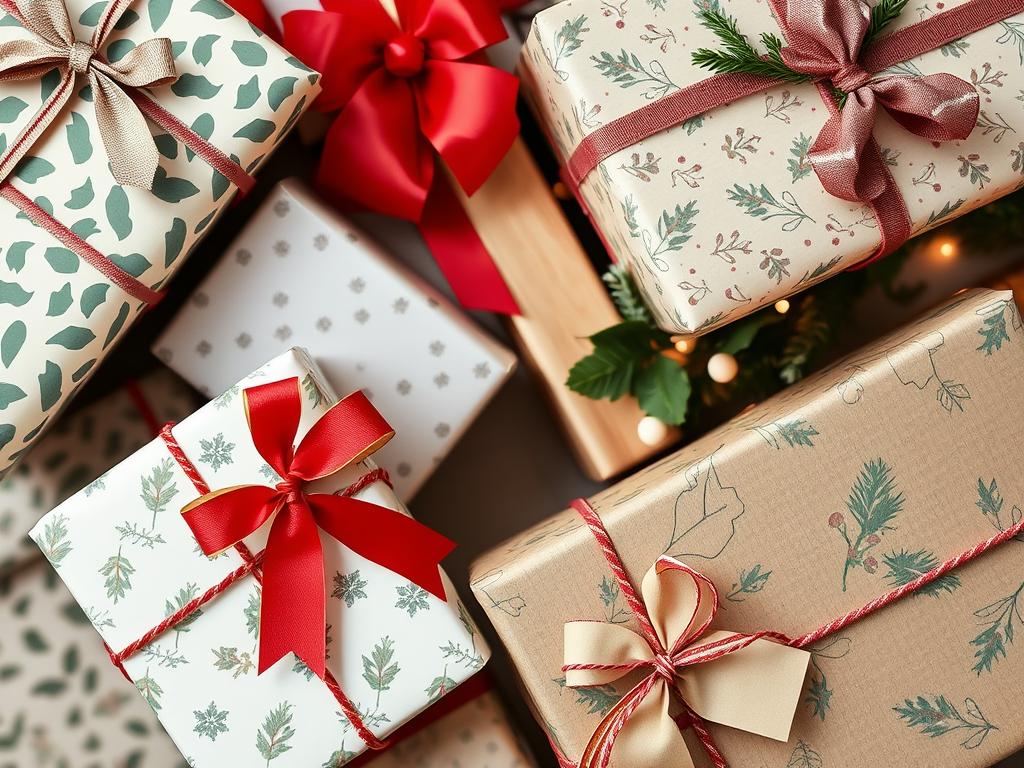
When Gifts Are Exchanged
The timing of gift exchanges varies by culture:
- In many European countries, gifts are exchanged on Christmas Eve (December 24)
- In North America, Christmas morning (December 25) is the traditional time for opening presents
- Some cultures exchange gifts on St. Nicholas Day (December 6)
- In Spain, Latin America, and some other countries, children receive gifts on Epiphany (January 6), commemorating the gifts of the Magi
Gift-Givers Around the World
Different cultures attribute gift-giving to various figures:
- Santa Claus/Father Christmas: North America, UK, Australia
- Père Noël: France
- Christkind: Parts of Germany, Austria, Switzerland
- La Befana: Italy
- The Three Kings: Spain, Latin America
- Jultomten: Sweden
- Ded Moroz (Grandfather Frost): Russia
- Joulupukki: Finland
- Babbo Natale: Italy
Gift-Giving Statistics: Americans spend an average of $942 on Christmas gifts each year. Globally, the Christmas shopping season accounts for up to 30% of annual retail sales, with online shopping continuing to grow in importance.
Christmas Food Traditions Around the World
Food lies at the heart of Christmas celebrations worldwide. From elaborate feasts to symbolic treats, these culinary traditions reflect cultural heritage, available ingredients, and the special nature of the holiday.
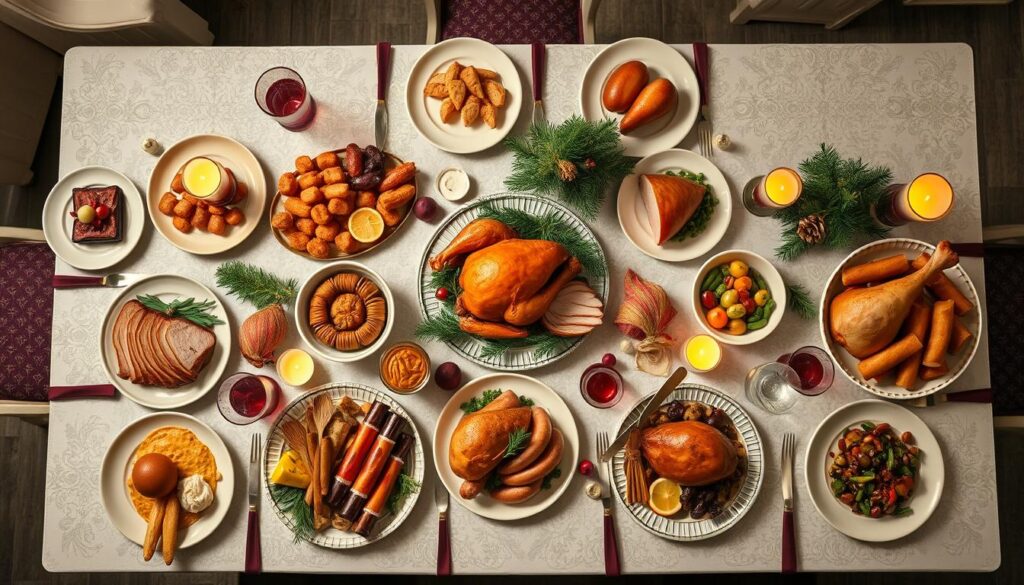
Traditional Christmas Meals
British and American Traditions
The classic Christmas dinner in Britain and America typically features roast turkey as the centerpiece, a tradition that became firmly established in the 19th century. Before turkey became widely available, Christmas meals in Britain often featured goose, beef, or in wealthy households, peacock or swan.
Accompaniments typically include:
- Stuffing or dressing
- Cranberry sauce
- Roast potatoes
- Brussels sprouts
- Gravy
- Christmas pudding or mince pies for dessert
European Variations
Italy
The Italian Christmas Eve tradition of the Feast of the Seven Fishes (La Vigilia) features multiple seafood dishes, reflecting the Catholic practice of abstaining from meat before feast days. Christmas Day meals often include pasta in brodo (pasta in broth), followed by roasted meats and panettone for dessert.
France
The French Réveillon is a long, late dinner held on Christmas Eve. Traditional dishes include oysters, foie gras, turkey with chestnuts, and the bûche de Noël (Yule log cake), a rolled sponge cake decorated to resemble a log, symbolizing the ancient tradition of burning a Yule log.
Scandinavia
In Sweden, the julbord (Christmas table) features ham, meatballs, lutfisk (dried fish reconstituted in lye), and rice pudding with an almond hidden inside—whoever finds it will have good luck. Norwegian Christmas often includes ribbe (pork ribs) or pinnekjøtt (dried lamb ribs).
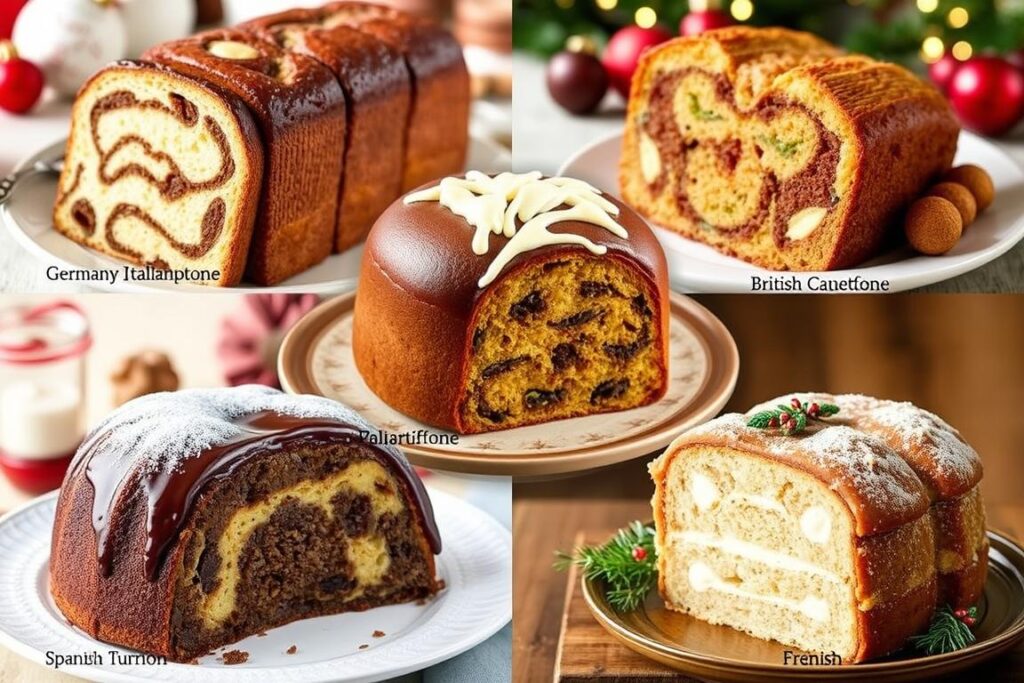
Christmas Sweets and Treats
Special desserts and confections are integral to Christmas celebrations:
Christmas Cookies
The tradition of baking special cookies for Christmas dates back to medieval European monasteries. German lebkuchen (gingerbread) has been documented since the 14th century. Today, Christmas cookie baking is a beloved tradition in many countries, with recipes passed down through generations.
Popular varieties include German springerle, Italian biscotti, Norwegian krumkake, and Russian tea cakes.
Christmas Cakes and Breads
Special breads and cakes mark Christmas across cultures:
- Stollen: German fruit bread with marzipan, dusted with powdered sugar
- Panettone: Italian sweet bread loaf with dried fruit
- King Cake: Served in many countries for Epiphany
- Rosca de Reyes: Mexican ring-shaped bread with a figurine of baby Jesus hidden inside
Christmas Beverages
Traditional drinks add warmth and cheer to Christmas gatherings:
Eggnog
This rich, creamy drink made with eggs, milk, sugar, and spirits originated in medieval England as “posset.” It became popular in colonial America, where abundant farms provided plenty of eggs and milk. George Washington’s recipe included rye whiskey, rum, and sherry!
Mulled Wine
Variations of spiced, heated wine appear across Europe: Glühwein in Germany, vin chaud in France, and glögg in Scandinavian countries. These warming drinks typically include cinnamon, cloves, star anise, and citrus, sometimes fortified with additional spirits.
Hot Chocolate
Traditional Christmas hot chocolate in many Latin American countries is thicker and richer than everyday versions, often flavored with cinnamon or vanilla. In Spain and parts of Latin America, churros are often served alongside for dipping.
Unique Christmas Celebrations Around the World
While many Christmas traditions are shared globally, each culture adds its own unique customs, creating a rich tapestry of celebrations that reflect local history, climate, and values.
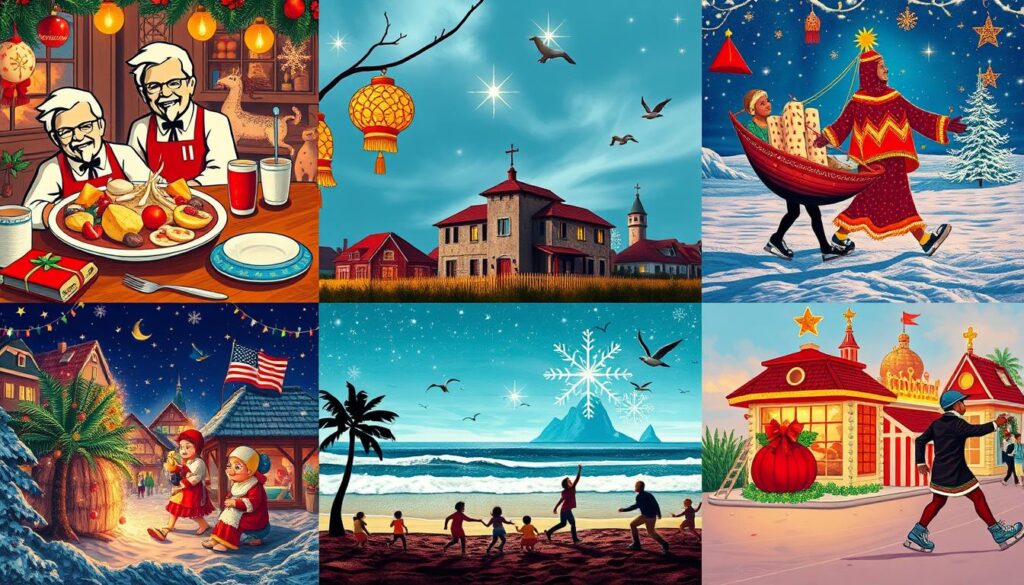
Asia
Japan
Christmas is not a national holiday in Japan, but has been adopted as a secular celebration. A unique Japanese Christmas tradition is eating Kentucky Fried Chicken for Christmas dinner—the result of a successful 1974 marketing campaign called “Kurisumasu ni wa kentakkii” (Kentucky for Christmas). The tradition is so popular that orders must be placed weeks in advance.
Christmas Eve is considered a romantic holiday similar to Valentine’s Day, with couples exchanging gifts and enjoying special dates.
Philippines
The Philippines boasts one of the world’s longest Christmas seasons, with celebrations beginning in September and extending into January. The country is famous for its parol lanterns—star-shaped decorations representing the Star of Bethlehem, traditionally made from bamboo and paper.
Simbang Gabi is a series of nine pre-dawn Masses leading up to Christmas. Those who complete all nine services are said to be granted a special wish. After the final Mass on Christmas Eve (Misa de Gallo), families gather for a midnight feast called Noche Buena.
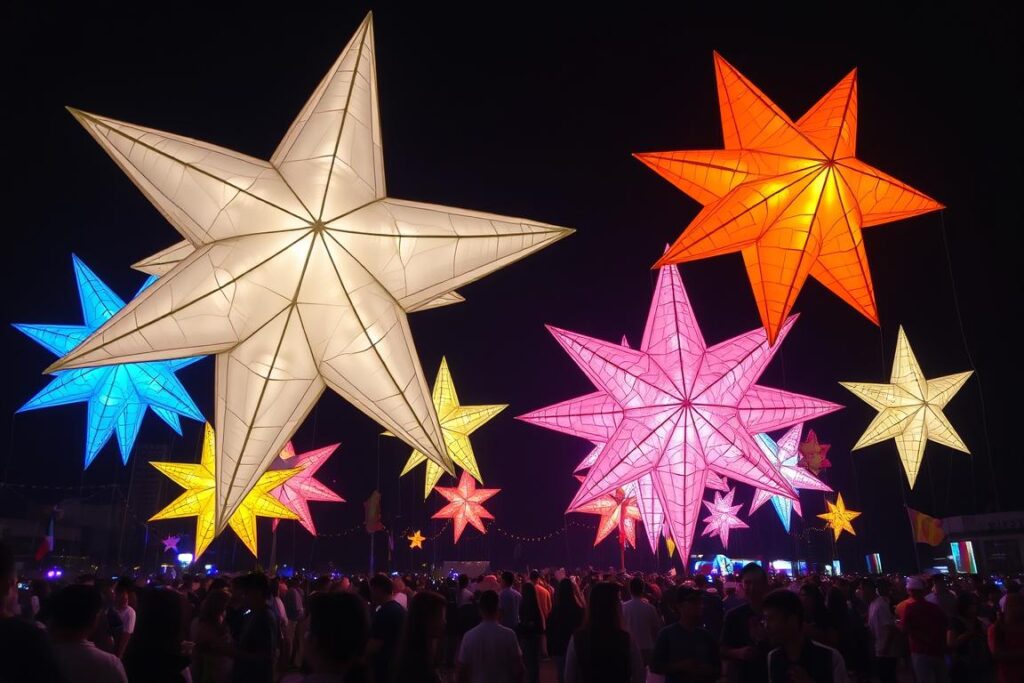
Europe
Iceland
Icelandic Christmas features the Yule Lads—13 mischievous troll-like characters who visit children on the 13 nights leading up to Christmas. Each has a distinct personality and name reflecting their preferred pranks, such as Spoon-Licker, Door-Slammer, and Window-Peeper. Children place shoes on their windowsills, receiving small gifts if they’ve been good or a potato if they’ve been naughty.
Norway
An unusual Norwegian Christmas Eve tradition involves hiding all brooms in the house. This custom dates back centuries to when people believed that witches and evil spirits came out on Christmas Eve looking for brooms to ride on. To prevent their brooms from being stolen, families would hide them in secure places.
Ukraine
Ukrainian Christmas trees are often decorated with spider web ornaments, based on a folk tale about a poor widow who couldn’t afford decorations. She woke on Christmas morning to find spiders had spun beautiful webs all over her tree, which turned to silver and gold in the morning light, bringing her good fortune.
Latin America
Mexico
Las Posadas is a nine-day celebration reenacting Mary and Joseph’s search for lodging in Bethlehem. From December 16-24, processions go from house to house, where participants are initially turned away before eventually being welcomed for a celebration with food, piñatas, and prayer.
Mexican Christmas celebrations culminate on January 6 (Día de los Reyes or Three Kings Day) when children receive gifts commemorating the presents brought by the Wise Men to Jesus.
Venezuela
In Caracas, Venezuela, a unique Christmas tradition involves roller skating to early morning church services during the week before Christmas. The practice is so established that streets are closed to cars until 8 a.m. to allow safe passage for skaters. The night before, children tie strings to their toes and hang them out of windows; passing skaters tug the strings the next morning to wake the children for church.
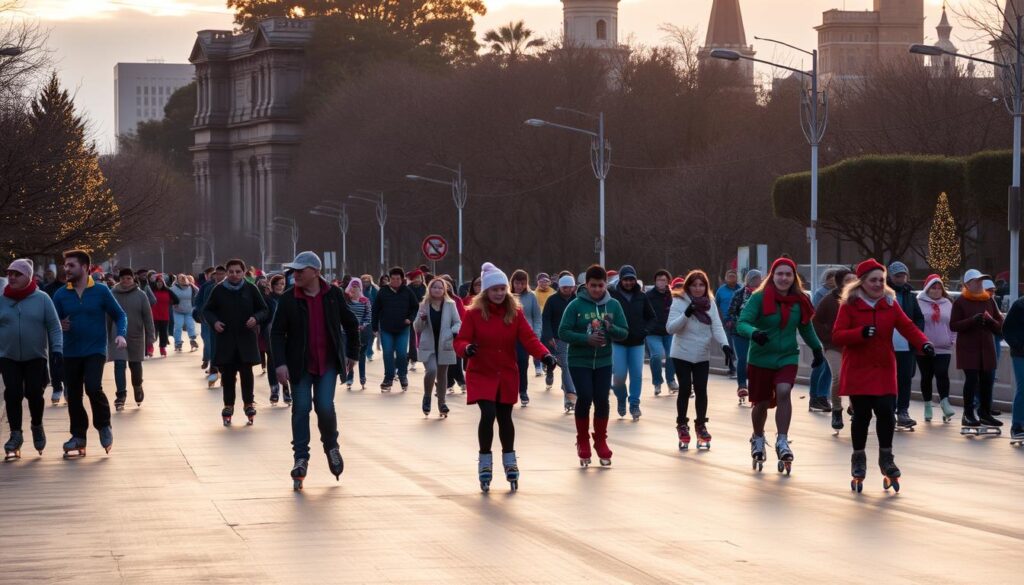
Africa and Oceania
Ethiopia
Ethiopian Orthodox Christians celebrate Christmas (called Ganna or Liddet) on January 7 according to the Julian calendar. The celebration begins with a day of fasting, followed by church services where worshippers dress in white. Traditional games similar to hockey are often played, as legend says the shepherds played such games when they heard of Christ’s birth.
The feast includes doro wat (spicy chicken stew) served with injera (flatbread). Twelve days after Ganna, Ethiopians celebrate Timkat, which commemorates Jesus’s baptism.
Australia
Christmas falls during summer in Australia, leading to unique traditions like “Carols by Candlelight”—outdoor concerts held on Christmas Eve where people gather with candles to sing carols. Many Australians celebrate Christmas with beach barbecues or picnics in parks.
Australian Christmas decorations often feature native flora like Christmas bush and Christmas bells. Santa is sometimes depicted wearing board shorts and arriving on a surfboard or in a four-wheel drive pulled by kangaroos instead of reindeer.
Christmas in South Africa: South Africans often celebrate Christmas with braais (barbecues) featuring traditional foods like sosaties (kebabs) and melktert (milk tart). Christmas crackers, carol singing, and decorated trees are popular, but with a distinctly African twist—decorations may include beadwork and handcrafted ornaments reflecting local artistic traditions.
Modern Christmas Trends and Adaptations
Christmas continues to evolve, adapting to changing social values, technological advancements, and global challenges. Today’s celebrations often blend traditional elements with contemporary innovations.

Digital Christmas
Technology has transformed how we celebrate Christmas:
- Virtual Gatherings: Video calls connect family members across distances, particularly important during the COVID-19 pandemic when many families couldn’t gather in person.
- Digital Advent Calendars: Online versions offer daily videos, games, or activities.
- Smart Decorations: App-controlled Christmas lights, smart trees, and digital projection displays create elaborate light shows.
- E-Cards and Digital Gifts: Electronic greeting cards and digital gift cards have become increasingly popular alternatives to paper cards and physical presents.
Sustainable Christmas
Environmental awareness has sparked interest in more sustainable holiday practices:
Eco-Friendly Decorations
Many people now choose:
- LED lights, which use up to 80% less energy than traditional bulbs
- Ornaments made from natural or recycled materials
- Potted Christmas trees that can be planted after the holidays
- Reusable advent calendars filled with small treats or activities rather than disposable ones
Sustainable Gift Practices
Environmentally conscious gift trends include:
- Experience gifts (tickets, classes, memberships) that create memories without material waste
- Handmade or locally produced items that reduce carbon footprints
- Second-hand or vintage gifts that extend the life of existing items
- Reusable or recyclable gift wrap alternatives like fabric furoshiki wraps or decorative boxes
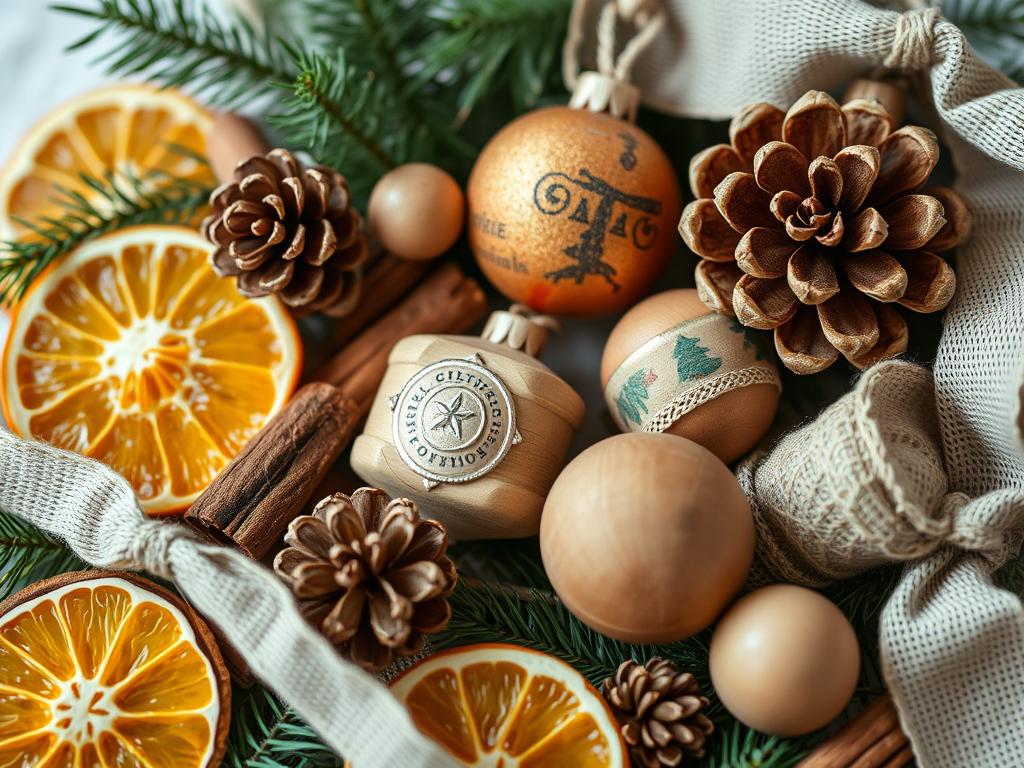
Inclusive Holiday Celebrations
As societies become more diverse, Christmas celebrations have adapted to be more inclusive:
Multicultural Approaches
Many families now blend traditions from different cultural backgrounds, creating unique hybrid celebrations. Interfaith families might celebrate both Christmas and Hanukkah (sometimes called “Chrismukkah”), incorporating elements from both holidays.
Secular Christmas
For many non-Christians, Christmas has become a cultural rather than religious holiday, focused on universal themes like family togetherness, generosity, and joy. Public celebrations increasingly emphasize winter themes and general holiday spirit rather than specifically Christian symbolism.
“Christmas is not a time nor a season, but a state of mind. To cherish peace and goodwill, to be plenteous in mercy, is to have the real spirit of Christmas.”
Alternative Christmas Celebrations
Not everyone celebrates Christmas in traditional ways:
Christmas Volunteering
Many people choose to spend Christmas Day volunteering at homeless shelters, nursing homes, or community kitchens, focusing on giving rather than receiving.
Travel Traditions
Some families opt to travel during the holidays instead of exchanging gifts, creating memories through shared experiences rather than material possessions.
Minimalist Christmas
The “less is more” approach emphasizes quality over quantity, with some families limiting gifts to a set number or following the “want, need, wear, read” formula to reduce consumption.
Fascinating Christmas Facts and Trivia
Beyond the familiar traditions lie surprising facts and intriguing tidbits about Christmas that showcase the holiday’s rich and sometimes unexpected history.
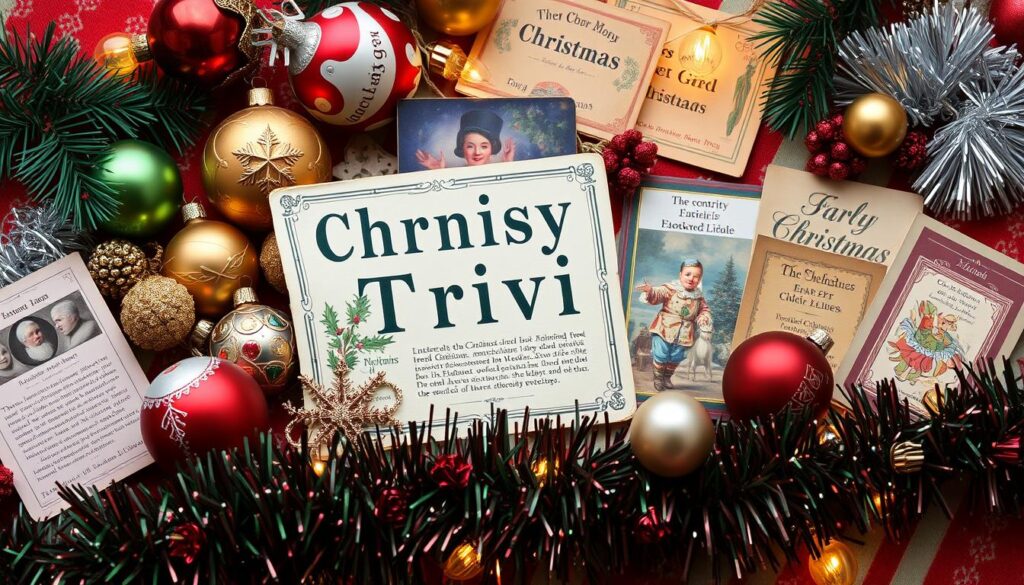
Historical Curiosities
- The first commercial Christmas cards were produced in London in 1843, the same year Charles Dickens published “A Christmas Carol.” Only 1,000 were printed, and original copies now sell for thousands of dollars at auction.
- Christmas was declared a federal holiday in the United States on June 26, 1870—relatively late compared to other major holidays.
- The Puritans of New England found no scriptural justification for celebrating Christmas, and the Massachusetts General Court punished anyone found celebrating with a five-shilling fine.
- Before turkey became the traditional Christmas meal in England, boar’s head was the centerpiece at medieval Christmas feasts. The tradition was celebrated in the carol “The Boar’s Head Carol,” still sung at Queen’s College, Oxford.
Decoration and Tree Trivia
Christmas Tree Records
- The tallest cut Christmas tree was a 221-foot Douglas fir displayed at Northgate Shopping Center in Seattle in 1950.
- The most expensive Christmas tree was valued at $11.4 million, displayed at the Emirates Palace hotel in Abu Dhabi in 2010. It was decorated with 181 pieces of jewelry including diamonds, pearls, emeralds, and sapphires.
- Artificial Christmas trees were developed in Germany during the 19th century and were made using goose feathers dyed green.
Ornament Origins
- Tinsel was invented in 1610 in Germany and was originally made from real silver, which tarnished from the heat of candles. It was later made from lead foil until the 1960s, when lead was recognized as a health hazard.
- The tradition of hanging stockings comes from a Dutch legend about St. Nicholas throwing gold coins down a chimney, which landed in stockings hung by the fire to dry.
- The first glass ornaments were created in Germany in the 16th century after a poor harvest left apple supplies too low for traditional tree decorations.
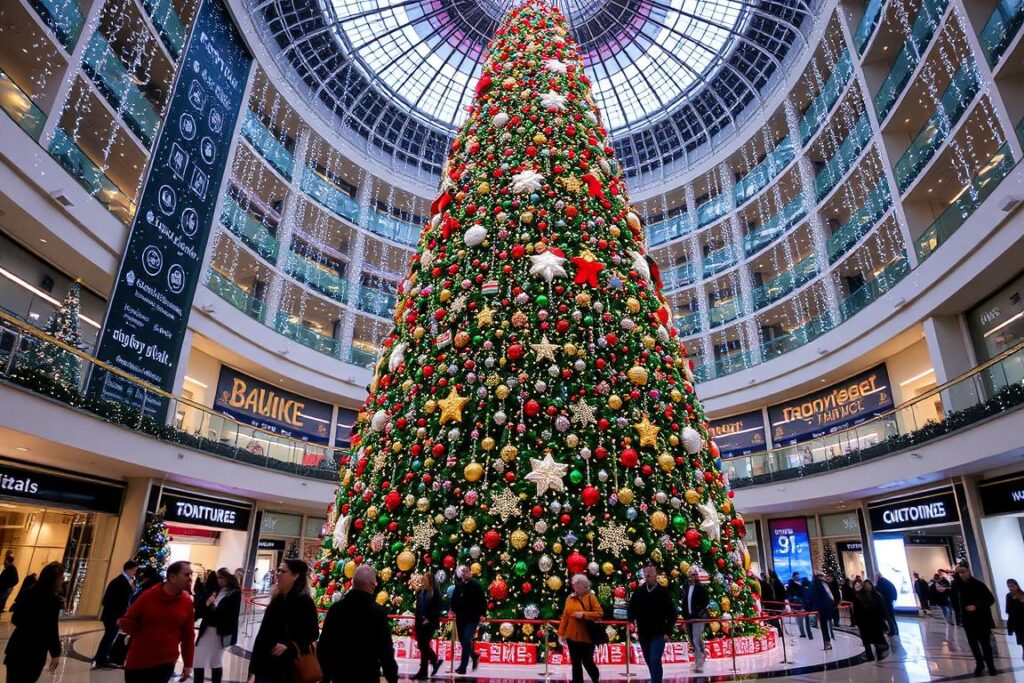
Christmas Music and Entertainment
- “Jingle Bells” was originally written for Thanksgiving, not Christmas, and was titled “One Horse Open Sleigh” when published in 1857.
- “Silent Night” was composed in 1818 by Franz Xaver Gruber with lyrics by Joseph Mohr after the church organ broke down in Oberndorf, Austria. It was first performed with just a guitar accompaniment.
- Rudolph the Red-Nosed Reindeer was created as a marketing tool for Montgomery Ward department stores in 1939. The store gave away 2.4 million copies of the Rudolph booklet in its first year.
- “White Christmas” by Bing Crosby is the best-selling single of all time, with over 50 million copies sold worldwide.
Global Christmas Statistics
Economic Impact
- Americans spend over $1 trillion on Christmas annually
- The average American spends $998 on gifts, decorations, and other holiday items
- Christmas tree farmers in the U.S. plant about 350 million trees, with 25-30 million sold each year
Cards and Wrapping
- Americans send approximately 1.6 billion Christmas cards each year
- If all the ribbon sold during the holiday season were tied together, it could circle the Earth multiple times
- Approximately 4.6 million pounds of wrapping paper is produced in the U.S. annually, with much of it ending up in landfills
Food Consumption
- 22 million turkeys are consumed in the U.S. during Christmas
- The average person consumes around 7,000 calories on Christmas Day—more than three times the recommended daily amount
- Over 1.76 billion candy canes are produced annually for the Christmas season
Did You Know? NORAD (North American Aerospace Defense Command) has tracked Santa’s journey on Christmas Eve since 1955. The tradition began accidentally when a department store advertisement misprinted a phone number for children to call Santa, and calls went to NORAD’s predecessor instead. Colonel Harry Shoup, the officer on duty, instructed his staff to give children updates on Santa’s location, beginning a beloved tradition that continues today.
The Enduring Spirit of Christmas
As we’ve explored throughout this guide, Christmas is a holiday of remarkable depth and diversity. From its ancient origins to its modern expressions, Christmas has continuously evolved while maintaining its core essence of light in darkness, generosity of spirit, and human connection.
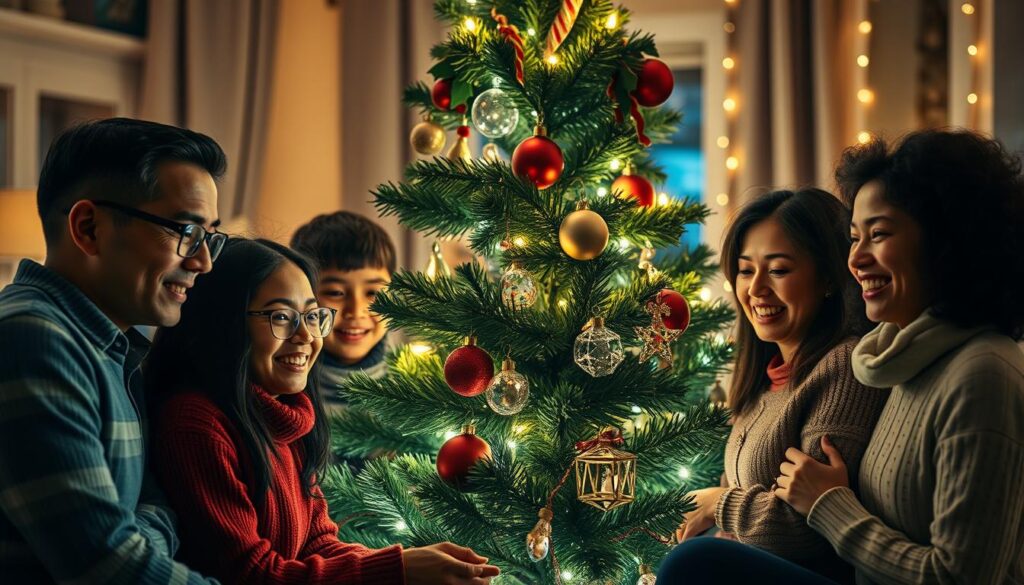
What makes Christmas truly remarkable is its ability to transcend boundaries. Though rooted in Christian tradition, its celebration extends far beyond religious lines, embraced by people of various faiths and cultural backgrounds worldwide. The holiday speaks to universal human desires for warmth during winter’s cold, connection amid isolation, generosity in a sometimes self-centered world, and hope during the darkest days of the year.
The traditions we’ve examined—from decorated trees and gift exchanges to festive meals and cultural celebrations—all serve as vehicles for these deeper meanings. They provide structure and ritual that help us pause from ordinary life to reflect, connect, and celebrate.
In an ever-changing world, Christmas continues to adapt while preserving its essential character. New technologies create novel ways to connect with distant loved ones. Environmental concerns inspire more sustainable practices. Multicultural influences enrich traditional celebrations with diverse perspectives. Yet through all these changes, the fundamental spirit of Christmas—expressed in countless ways across cultures and generations—remains a powerful force for bringing light, joy, and human connection to our world.
Whether you celebrate Christmas as a religious observance, a cultural tradition, or simply a time for family and friends, may the spirit of the season—with its messages of peace, goodwill, and joy—enrich your life and inspire you throughout the year.
“I will honor Christmas in my heart, and try to keep it all the year.”
